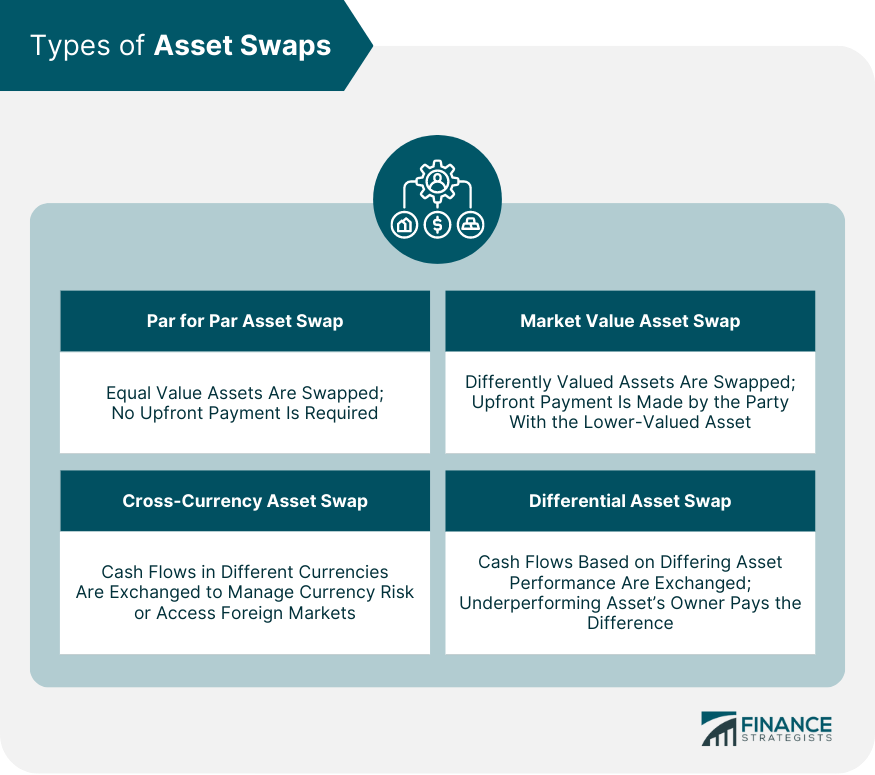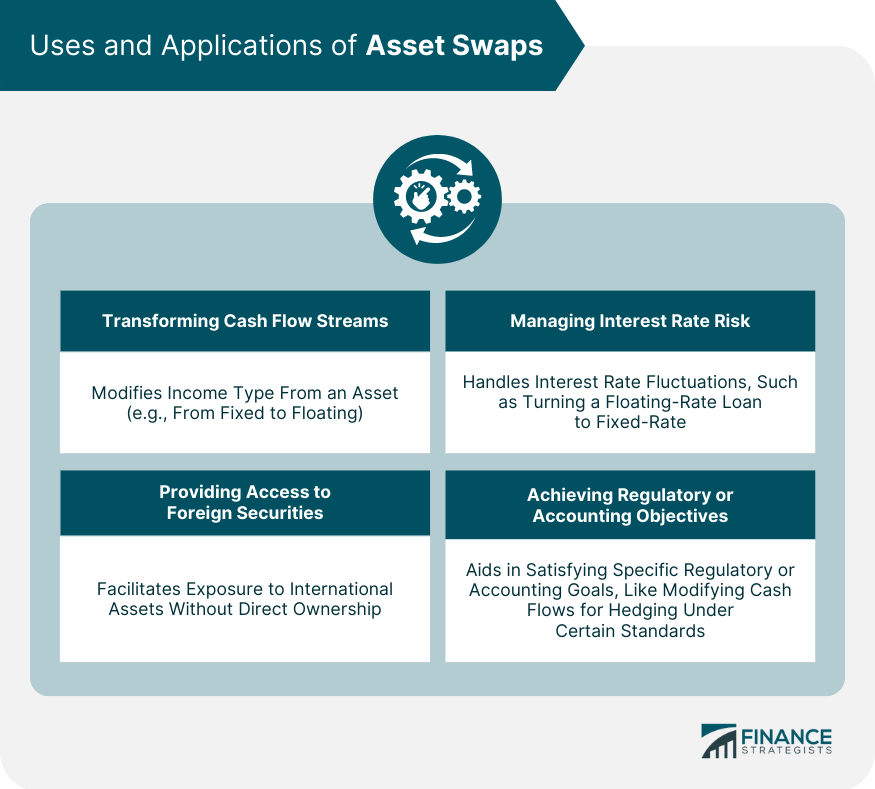An asset swap is a financial derivative instrument designed for several key purposes. It allows investors to alter the nature of their income streams, hedge against various financial risks like interest rate fluctuations and credit default, and gain exposure to foreign markets. The key components of an asset swap include a fixed income security (typically a bond) and an interest rate swap contract. The fixed income security's cash flows are exchanged with those of the swap counterparty's asset, which can be either fixed or floating, as specified in the swap agreement. Asset swaps come in several types, including par for par, market value, cross-currency, and differential swaps. Each type offers different benefits and risk exposures, providing a versatile tool for investors to adjust their portfolios in line with their financial goals and risk tolerance. Asset swaps serve various purposes. Primarily, they allow investors to transform the income stream of their assets without having to dispose of the original asset. This transformation could be from fixed to floating rates or vice versa. Asset swaps are also used to manage risks associated with interest rates, currency fluctuations, and creditworthiness. Furthermore, they enable investors to access foreign markets and adhere to specific regulatory or accounting standards. The cornerstone of any asset swap is the fixed income security, typically a bond. This security is the primary source of the cash flows that will be exchanged during the swap. The fixed income security can either pay a fixed or floating rate of interest. The second essential component is the interest rate swap, a derivative contract through which the two parties exchange cash flows. The interest rate swap determines the nature of the cash flows to be exchanged, either fixed or floating. There are two primary parties involved in an asset swap - the asset holder and the swap counterparty. The asset holder is the party that owns the fixed income security, while the swap counterparty is the party that agrees to exchange the cash flows from another asset. The process begins when the two parties agree on the terms of the asset swap. The asset holder will receive the cash flows from the swap counterparty's asset and pay the cash flows from the fixed income security. The frequency and duration of these payments are outlined in the swap agreement. The pricing of an asset swap is based on the present value of the future cash flows from the fixed income security and the swap. The difference between these two values is called the swap spread. In an asset swap, the cash flows exchanged between the parties can be either fixed or floating. The cash flows are usually netted against each other, with the party owing the larger amount paying the difference to the other party. In a par for par asset swap, the fixed income security and the swap are of equal value. Therefore, there is no upfront payment from either party at the beginning of the swap. In a market value asset swap, the fixed income security and the swap have different market values. The party with the lower-valued asset will make an upfront payment to the other party to balance the values. A cross-currency asset swap involves the exchange of cash flows in different currencies. This type of swap is typically used to hedge against currency risk or gain exposure to foreign markets. In a differential asset swap, the cash flows exchanged are based on the performance difference between two assets. The party that owns the underperforming asset pays the difference to the party that owns the outperforming asset. Asset swaps are often used to transform the nature of the cash flows from an asset. For instance, a bondholder could use an asset swap to convert the fixed interest payments of a bond into floating interest payments. Asset swaps can also be used to manage interest rate risk. For instance, a company with a floating-rate loan could use an asset swap to convert its debt service payments to a fixed rate, thereby hedging against the risk of rising interest rates. Through a cross-currency asset swap, an investor can gain exposure to foreign securities without actually owning the foreign asset. This can be a useful strategy for investors looking to diversify their portfolios geographically. In some cases, asset swaps can be used to meet specific regulatory or accounting standards. For example, a company might use an asset swap to transform the cash flows from a non-qualifying asset into qualifying cash flows for hedging purposes under certain accounting standards. One of the key risks in asset swaps is credit risk, which is the risk that the swap counterparty will default on their obligations. This risk can be mitigated through the use of collateral or credit support agreements. Interest rate risk arises from changes in interest rates, which can affect the value of the fixed income security and the swap. This risk can be managed through the use of interest rate swaps or other interest rate derivatives. In a cross-currency asset swap, there is a risk of currency fluctuations that can affect the value of the cash flows exchanged. This risk can be managed through the use of currency swaps or other currency derivatives. Liquidity risk refers to the risk that the asset holder might not be able to easily sell the fixed income security or terminate the swap. This risk can be mitigated by entering into swaps with highly liquid underlying assets or reputable counterparties. The asset swap spread is the difference between the yield of the fixed income security and the swap rate. It is a key metric used in pricing asset swaps and gauging the credit risk of the fixed income security. Various factors can influence asset swap spreads, including the creditworthiness of the issuer of the fixed income security, the duration of the swap, and market conditions. A wider asset swap spread indicates a higher perceived credit risk of the fixed income security, while a narrower spread indicates a lower perceived risk. Investors use the asset swap spread as a measure of the additional yield they require for taking on the credit risk of the fixed income security. Asset swaps can play a crucial role in asset-liability management. By transforming the cash flows from their assets, investors can better match their income streams with their liabilities. Through cross-currency asset swaps, investors can diversify their portfolios by gaining exposure to foreign markets without having to invest directly in foreign assets. By entering into asset swaps with higher-yielding underlying assets, investors can enhance the yield of their portfolios without increasing their risk exposure. One successful implementation of asset swaps is by global investment banks, which use them to transform the fixed interest payments from their bond holdings into floating interest payments. This allows them to match their income streams with their floating-rate liabilities, thereby managing their interest rate risk effectively. As financial markets continue to evolve, we can expect to see further innovations in asset swap structures. For instance, we could see the development of asset swaps involving new asset classes, such as cryptocurrencies or other digital assets. Changes in financial regulations could also have a significant impact on the asset swap market. For example, changes in accounting standards could affect the use of asset swaps for hedging purposes, while stricter regulations on derivative transactions could impact the liquidity and pricing of asset swaps. Certain market trends could influence the use and popularity of asset swaps. For instance, if interest rates rise, we could see increased demand for asset swaps as investors look to manage their interest rate risk. Conversely, if credit conditions tighten, the asset swap spreads could widen, making asset swaps more expensive. Asset swaps serve as a powerful financial tool that offers the flexibility to transform investment income streams, manage diverse financial risks, and access international markets. The key components of an asset swap, a fixed income security and an interest rate swap, create a dynamic system in which cash flows can be exchanged, further enhancing an investor's ability to fine-tune their portfolio. Various types of asset swaps, including par for par, market value, cross-currency, and differential, provide a range of options to suit different investment needs and risk profiles. The versatility of asset swaps makes them an essential instrument in the world of finance, providing investors with the means to adapt their strategies to changing market conditions and personal financial objectives. Understanding the purpose, key components, and types of asset swaps is crucial to effectively utilizing these instruments in financial planning and investment management.Definition of an Asset Swap
Purpose of Asset Swaps
Key Components of Asset Swaps
Fixed Income Security
Interest Rate Swap
Parties Involved in an Asset Swap
Mechanics of an Asset Swap
Process of an Asset Swap
Pricing an Asset Swap
Cash Flows in an Asset Swap
Types of Asset Swaps

Par for Par Asset Swap
Market Value Asset Swap
Cross-Currency Asset Swap
Differential Asset Swap
Uses and Applications of Asset Swaps

Transforming Cash Flow Streams
Managing Interest Rate Risk
Providing Access to Foreign Securities
Achieving Regulatory or Accounting Objectives
Risks Involved in Asset Swaps
Credit Risk
Interest Rate Risk
Currency Risk
Liquidity Risk
Asset Swap Spreads
Role of Asset Swaps in Portfolio Management
Asset-Liability Management
Diversification of Investments
Yield Enhancement
Successful Implementation of Asset Swaps
Future of Asset Swaps
Innovations in Asset Swap Structures
Impact of Regulatory Changes on Asset Swaps
Potential Market Trends Influencing Asset Swaps
Conclusion
Asset Swap FAQs
An asset swap is a financial derivative contract through which two parties exchange the cash flows of two different assets. It is often used to alter the income stream of an asset, manage various financial risks, and provide access to foreign markets.
In an asset swap, one party, the asset holder, exchanges the cash flows from a fixed income security (usually a bond) with the cash flows from another asset owned by the swap counterparty. The cash flows can be fixed or floating, and the terms of the swap are outlined in a swap agreement.
The main types of asset swaps include par for par, market value, cross-currency, and differential asset swaps. Par for par and market value swaps involve the exchange of cash flows from assets of equal or different values, respectively. Cross-currency swaps involve the exchange of cash flows in different currencies, while differential swaps are based on the performance difference between two assets.
The main risks associated with asset swaps include credit risk (the risk of default by the swap counterparty), interest rate risk (the risk of changes in interest rates affecting the value of the swap), currency risk (in cross-currency swaps), and liquidity risk (the risk of not being able to sell the asset or terminate the swap easily).
Asset swaps play a crucial role in portfolio management. They can be used for asset-liability management by transforming the cash flows from assets to match liabilities. They also offer opportunities for diversification by providing access to foreign markets, and they can enhance portfolio yield by swapping into higher-yielding assets.
True Tamplin is a published author, public speaker, CEO of UpDigital, and founder of Finance Strategists.
True is a Certified Educator in Personal Finance (CEPF®), author of The Handy Financial Ratios Guide, a member of the Society for Advancing Business Editing and Writing, contributes to his financial education site, Finance Strategists, and has spoken to various financial communities such as the CFA Institute, as well as university students like his Alma mater, Biola University, where he received a bachelor of science in business and data analytics.
To learn more about True, visit his personal website or view his author profiles on Amazon, Nasdaq and Forbes.















